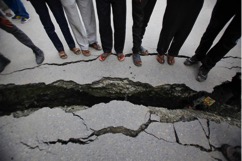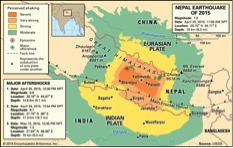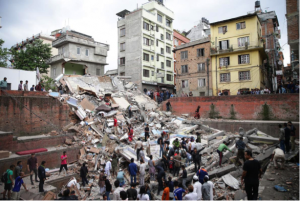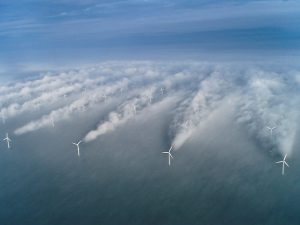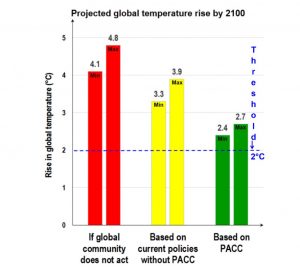On April 25, 2015, a 7.8 magnitude earthquake hit the Gorkha district of Nepal. During the months afterward, the country experienced hundreds of aftershocks, many with a magnitude greater than or equal to 4.0 and some greater
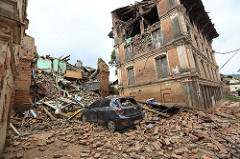
Aftermath of the earthquake in Sankhu, Nepal.
Laxmi Prasad Ngakhusi, UNDP Nepal, 28 Apr. 2015.
than 6.0 (Shrestha 1). The event had a devastating effect on Nepal’s population. The International Centre for Integrated Mountain Development (ICIMOD) reports that “Within Nepal, there were more than 8,800 casualties, 22,000 people reported injured, and 100,000 people displaced” (Shrestha 2). This level of destruction demonstrates the need for an extensive recovery process, and for measures to prevent such devastation in the future. The way that Nepal carries out the recovery process and prepares for future disasters could heavily impact the security of its people in the face of climate change.
Although the earthquake was not a climate related disaster, its effects are likely to interact with those of climate change and make climate-related challenges even more difficult. According to an assessment by Nepal’s Ministry of Science, Technology and Environment, the destruction caused by the earthquake has increased the vulnerability of many people to other natural disasters (Nepal Earthquake 20). One reason for this increased vulnerability is that the earthquake has created conditions for greater destruction. A case study from Dartmouth College notes that climate change is the suspected cause of fluctuations in the monsoon season, which have disrupted agriculture and caused food insecurity. The earthquake has exacerbated this problem by destroying crops and disrupting the hillside terraces where many people grow their food. The disrupted terraces are also more likely to collapse during future storms (“Monsoons”). In this way, the earthquake has made the difficulties already caused by climate change even more dangerous and complex.
Many people also find themselves less prepared to respond to these challenges. A report by the the International Centre for Integrated Mountain Development (ICIMOD) finds that the earthquake has worsened the country’s already high level of poverty, forcing an estimated 700,000 people below the poverty line (Shrestha 2). Without the economic resources to meet their basic needs, these people do not have the reserves necessary to endure future hardships. Similarly, relief efforts responding to urgent needs in the immediate aftermath of the earthquake may not account for challenges down the road. As people construct new homes in the wake of disasters, they tend to ignore environmental consequences and fail to incorporate sustainable practices. As a result, they may not use natural resources effectively and may experience poor living conditions and more severe exposure to environmental threats (Nepal Earthquake 21). In addition, the need to move thousands of people’s homes to new locations creates a risk of further environmental disturbance and an additional need for natural resources (Country Environment Note 20). This situation compounds the limits on resources which climate change already poses and leaves people more vulnerable to unexpected weather events.
Although the recovery process presents many challenges, it may lead to much better conditions if approached in the right way. Nepal’s Ministry for Science, Technology and Environment argues that the rebuilding process provides an opportunity to recreate communities in ways that take environmental concerns into account, better preparing people for future challenges and accelerating the process of “ecosystem-based sustainable development, economic progress, and poverty reduction.” (Nepal Earthquake 19). By upsetting existing systems, the earthquake has cleared the way to design more effective ones. The need for discussion of recovery efforts invites reconsideration of the way communities have been designed in the past. Possible solutions include training sessions and policy reviews to help people manage resources more effectively. It would also be helpful to track environmental threats and set up warning systems (22). These actions would help people adapt to climate change. If responders also make an effort to reduce pollution and greenhouse gas emissions, they could help to lessen the effects of climate change directly. In the aftermath of the earthquake, Nepal’s situation may be grim, but there is still room for hopeful possibilities.
References
Country Environment Note: Nepal. Asian Development Bank, 2014, https://www.adb.org/sites/default/files/institutional-document/154702/country-environment-note-nepal.pdf. Accessed 10 Sept. 2017.
Nepal Earthquake 2015: Rapid Environmental Assessment. Government of Nepal: Ministry of Science, Technology and Environment, Nov. 2015.
“Monsoons.” Nepal Earthquake Case Studies, Dartmouth College, http://sites.dartmouth.edu/NepalQuake-CaseStudies/monsoons/. Accessed 10 Sept. 2017.
Shrestha, Arun Bhakta, Samjwal Ratna Bajracharya,Jeffrey S. Kargel, Narendra Raj Khanal. The Impact of Nepal’s 2015 Gorkha Earthquake-Induced Geohazards. ICIMOD Research Report 2016/1. Kathmandu: ICIMOD, 2016, http://lib.icimod.org/record/31937/files/icimod-2015-Earthquake-InducedGeohazards.pdf. Accessed 11 Sept. 2017.

